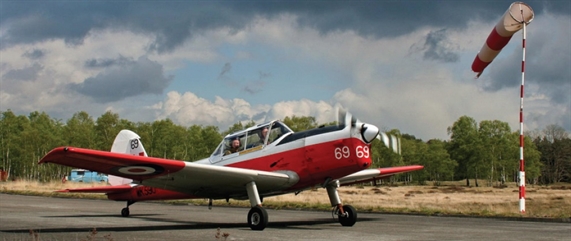
De Havilland Canada DHC-1 Chipmunk
After producing, under license, Tiger Moth and Mosquito, de Havilland Canada designed their first aircraft, the DHC-1 Chipmunk. The Chipmunk prototype, flew for the first time at Downsview, Toronto on 22 May 1946 with Pat Fillingham, test pilot from the parent de Havilland company, at the controls.The concept proved correct and the Chipmunk soon entered service in the Royal Canadian Air Force as a primary trainer. Two Chipmunk aircraft were evaluated by the Aeroplane and Armament Experimental Establishment (A&AEE) at RAF Boscombe Down. As a result, the fully aerobatic Chipmunk was ordered as an ab initio trainer for the Royal Air Force. The last RAF Chipmunk remained in service until 1997.
The Chipmunk was used by several other Air Forces: Belgium, Burma, Ceylon, Colombia, Denmark, Eire, Egypt, Ghana, Iraq, Jordan, Kenya, Lebanon, Portugal, Saudi Arabia, Syria, Thailand, Uruguay and Zambia.
The Chipmunk was used by several other Air Forces: Belgium, Burma, Ceylon, Colombia, Denmark, Eire, Egypt, Ghana, Iraq, Jordan, Kenya, Lebanon, Portugal, Saudi Arabia, Syria, Thailand, Uruguay and Zambia.

ANORACK FACT:
20 years after designing the chipmunk, W.J. Jakimiuk was a key member of the…Concorde design team.
20 years after designing the chipmunk, W.J. Jakimiuk was a key member of the…Concorde design team.
N°69
DHC-1 Chipmunk serial WK590 was accepted by the RAF in 1954. It served with N°11 reserve Flying School at Perth, then with the Edinburgh University Air Squadron and later with the 63 Communication Group at Sealand. WK590 then spent a record 25 years of service with N°9 Air Experience Flight.
In 1996, its current owner grabbed the opportunity to buy it at a Ministry of Defence auction. Nowadays WK590 is still lovingly kept in flying condition in an as original condition as possible.
In 1996, its current owner grabbed the opportunity to buy it at a Ministry of Defence auction. Nowadays WK590 is still lovingly kept in flying condition in an as original condition as possible.

